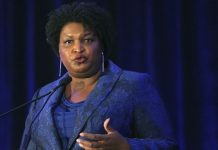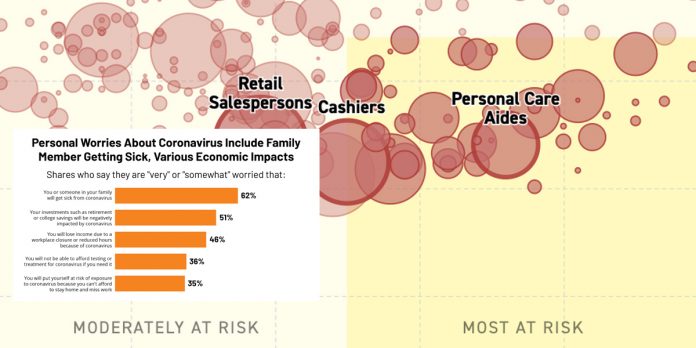Lowest-Income Workers Most At Risk In The Coronavirus Crisis
Who is most at risk in the coronavirus crisis: 24 million of the lowest-income workers
Cashiers, nursing assistants, paramedics: These people are at highest risk of exposure to coronavirus — and make a median wage of less than $35,000 a year
Unemployment claims have started soaring as state and federal officials restricted public gatherings and shuttered stores to prevent the spread of the COVID-19. Using wage data from the U.S. Department of Labor and working conditions surveys from O*NET, we analyzed those who are most vulnerable.

First, we looked at the bottom quarter of earners — people in jobs that pay less than $35,000 a year. Next, we narrowed that list to people who work at an arm’s length or less from others during their regular shifts, according to workforce survey data.
This group, nearly 24 million people — or about 15 percent of the American workforce — is at the highest risk of suffering injury from the COVID-19 pandemic. Among them are bartenders, paramedics, home health aides, janitors, drivers and more.
The chart below plots more than 600 jobs, arranging them by how much they pay and how much they involve human contact. We’ve highlighted the most-at-risk zone, using the criteria above. We’ve also shown a moderately-at-risk zone, which includes professions that pay the up to median wage and require contact equivalent to working in a shared office.

Service sector jobs make up the bulk of this vulnerable population, led by cashiers, waitstaff and care aides. Cashiers alone hold more than 3.5 million jobs, more than registered nurses or school teachers.
And while other workers — including janitors and office clerks — make comparable salaries, they’re less likely to depend on constant direct human contact for their livelihoods, according to O*NET data.
Government data shows workers in this salary tier are also less likely to get the kinds of benefits that would help them weather disruptions in work. Only 51 percent of employees in the bottom quarter of pay nationally say they get paid sick leave; only 1 percent say they have remote-friendly jobs.

What’s more concerning, however, is how much the population of affected workers balloons when this analysis is expanded, even slightly, to moderately at risk jobs.
If we bump the pay ceiling to $48,000 — the median wage in the Department of Labor data — and include jobs that require moderate proximity to other people, we’re now looking at 69 million workers, more than 40 percent of the total American workforce.
This would include 4.4 million retail salespersons, which is the largest single job category in the country. Also added are dental assistants, who score a nearly chart-topping 99 on the people-proximity scale, and make around $38,660.![]()
Consider supporting AMIBC™. Contribute by clicking on the advertisers and sponsors featured on AMIBC™ and please utilize them. Readers from around the world, like you, make our work possible. We need your support to deliver quality, vetted, investigative journalism – and to keep it open for everyone. At a time when factual, honest reporting is critical, your support is essential in protecting our editorial independence.
The narratives and issues impacting all Americans is tantamount to the AMIBC™ platform. Every contribution, however big or small, is valuable for our future. Make sure to join the AMIBC Founders Club to maximize the total advantage of being a subscriber.
































